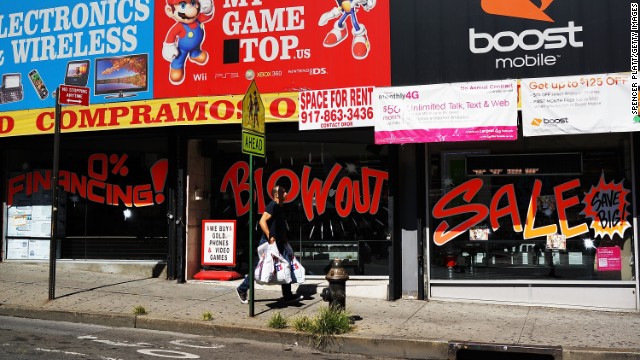Urban poverty, in black and white
updated 9:20 AM EDT, Fri July 11, 2014

Discoveries revealed from a 25-year study in Baltimore may hold truths for other urban areas, such as the South Bronx.
STORY HIGHLIGHTS
- Authors: "Urban poor" is not just black men, single moms; many whites fit the category
- For 25 years, authors studied poor children through their adulthood in Baltimore
- Authors: Hardly any poor children, black or white, went on to finish college
- They say white privilege won out as they got more and better-paying jobs
Editor's note: Karl
Alexander is the academy professor and sociology research professor at
Johns Hopkins University. Linda Olson is a research scientist at the
Baltimore Education Research Consortium and the Hopkins Center for
Social Organization of Schools. They are co-authors, with Doris
Entwisle, of the book "The Long Shadow: Family Background, Disadvantaged Urban Youth, and the Transition to Adulthood," published by the Russell Sage Foundation. The opinions expressed in this commentary are solely those of the writers.
(CNN) -- Say "urban poor," and the image that most
likely comes to mind is one of young black men caught up in a swirl of
drugs and violence and irresponsible single women having babies. But
this pervasive stereotype overlooks a surprising reality: Many whites
live side by side African-Americans in some of the country's poorest
urban neighborhoods.
Because white poverty is
less expected, less recognized and less studied, we often exclude poor
whites from our discussions. That masks a fundamental truth about
economic inequality: Poverty is colorblind. But neither is it the same
for everyone, as the white poor benefit from a lifetime of the hidden
perks of white privilege.
As our nation continues
down the road of economic recovery, this is a reality our local and
national policymakers cannot afford to ignore as they seek to address
employment and income inequality.
We traced the experience
of nearly 800 children in Baltimore for more than 25 years, from the
time they entered first grade in the fall of 1982 in 20 Baltimore public
schools to well into their third decade. Half their families were low
income, according to school records, and the typical low-income parent
hadn't finished high school. What might be surprising is that of that
half, 40% are white.

Karl Alexander

Linda Olson
Looking at where these
children started in life and where they ended up, the study results are
troubling but clear: At 28, hardly any of the children from a
disadvantaged background, black or white, had finished college.
But even without the
benefit of a college degree, whites, and white men especially, had
vastly better employment outcomes. At every age, the white men
experienced shorter spells of unemployment, were more likely to be
working full-time and earned more.
Baltimore, like so many
other American cities, suffered immensely under the ravages associated
with de-industrialization: the loss of industry, population and wealth.
Under such circumstances, many of the city's disadvantaged youths
stumbled along the way.
But the consequences have
been especially dire for African-Americans. As young adults,
African-American men had fared much worse than whites in the job market,
even though they and their white counterparts had about the same levels
of education and the whites reported higher rates of marijuana and
heavy drug use and binge drinking.
Take, for example, the
types of jobs the men in our study held. At 28, nearly half of the white
men who had not attended college were employed in the industrial and
construction trades, the highest-paying sector of blue-collar
employment. By contrast, only 15% of African-American men worked in
these sectors, and even within that small group, annual earnings were
less than half that of whites -- $21,500 versus $43,000.
This disparity is no accident.
It fits a broader
pattern evident as far back as high school: About one-fifth of white men
who grew up in disadvantaged families had after-school and summer jobs
in these industries -- important experience that can help secure a
full-time job -- while not a single African-American person did.
Indeed, throughout the
course of our study, it was clear that African- Americans face greater
barriers to employment. Having an arrest record or failing to complete
high school were less consequential for white men than for
African-American men: 84% of whites without a high school degree were
employed at 22; among African Americans, just 40% were.
Racial inequality also
is embedded in hidden ways in other spheres of life, including
discrimination in housing and banking practices that have kept white and
black Baltimore substantially separate and cut off working class
African-Americans from potentially valuable social contacts.
Why do differences in employment track so sharply with color lines?
The race-based privilege
that benefits working-class whites over working-class African-Americans
has its origins in the discriminatory practices that excluded
African-Americans from the skilled trades during Baltimore's booming
World War II and post-war industrial economy.
Although overt racial
discrimination has lessened since then, the deep structural inequalities
these barriers helped establish continue today through word-of-mouth
hiring, employer attitudes that limit opportunities for
African-Americans and segregated social networks.
The differences in how
these young people found jobs illustrate the invisible ways race-based
privilege is institutionalized in the job market.
When asked at age 22 how
they found their current jobs, whites more often mentioned help from
family and friends, while more African-Americans found jobs "on their
own." The white job seekers in our study had family, friends and
neighbors who could help them access good-quality, higher-paying jobs.
And what of those women having babies?
Most of the women of
disadvantaged background, white and African-American, became mothers as
teenagers, worked sporadically and when working, their employment was
concentrated in the low-pay clerical and service sectors.
The difference, though,
is that many more white women were married or in a stable co-habiting
relationship. An additional earner in the household makes a vast
difference in economic well-being, which means that white men's
workplace advantages benefit white women as well.
As Americans, we like to
think that we are all on a level playing field. Our society treasures
rags-to-riches stories of individuals overcoming their humble origins to
achieve the American Dream. But, the harsh reality we witnessed in
Baltimore is that race and class place severe limitations on a child's
ability to achieve that dream.
Too often, our
policymakers focus on colorblind solutions, such as the Earned Income
Tax Credit, to help the urban poor. Such programs only help those who
already have jobs and fail to address chronic unemployment among
African-Americans.
Amid the growing
national conversation on economic inequality, now is the time for our
leaders to recognize that race matters and develop creative programs,
such as President Barack Obama's "My Brother's Keeper" initiative, to
address the different challenges facing poor African-Americans.
Tracking the lives of
Baltimore children for 25 years, we witnessed all too clearly how family
conditions and poverty early in life cast a shadow that follows
children into adulthood and how that shadow extends much further if you
are African-American.
Only by facing this
reality head on with proactive programs and policies can we offer young
African-Americans a fair shot at achieving the American dream.
insanity workout, mac cosmetics, vans outlet, ghd, moncler, moncler, wedding dresses, moncler outlet, abercrombie and fitch, jimmy choo shoes, north face outlet, instyler ionic styler, north face jackets, roshe run, canada goose pas cher, new balance outlet, uggs outlet, rolex watches, asics shoes, ugg outlet, soccer shoes, canada goose uk, herve leger, birkin bag, longchamp, canada goose, reebok shoes, canada goose outlet, valentino shoes, canada goose outlet, ferragamo shoes, nfl jerseys, uggs on sale, p90x workout, soccer jerseys, hollister, lululemon outlet, mcm handbags, ugg soldes, celine handbags, ugg boots, mont blanc pens, canada goose outlet, chi flat iron, bottega veneta, marc jacobs outlet, ugg, beats headphones, giuseppe zanotti, babyliss pro
ReplyDeletejordan legend 11, jordan legend blue 11, 378037-117,air jordan 11s legend blue, air jordan 11 legend blue,
ReplyDeletelegend blue 11s 2014, legend blue 11s, jordan 11 legend blue, retro legend blue 11s, jordan 11s legend, pre order legend blue 11s, 378037-117, air jordan legend 11s, legend 11s, legend blue 11s, air jordan 11s legend blue, jordan legend 11s, legend 11s 2014, retro legend 11s, pre order legend 11s, 378037-117,air jordan 11s legend blue ,pre order legend blue 11s ,legend blue 11s ,jordan 11s legend blue ,retro legend blue 11s ,jordan 11s legend ,pre order legend blue 11 ,378037-117 ,air jordan 6s black infrared ,black infrared 6s ,jordan infrared 6s ,infrared 6s ,jordan 6s black infrared ,pre order black infrared 6s,384664-023
ReplyDeleteارخص شركة نقل عفش بالرياض
__________